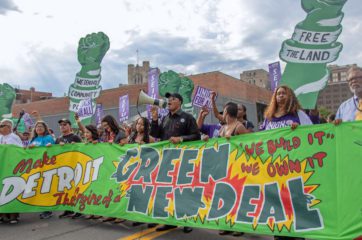This article was submitted by a member of our State Climate Policy Network (SCPN) — a rapidly-growing program within the organization that includes more than 16,000 advocates and policymakers across the country who are pushing for effective and equitable climate policies in their states. The views, thoughts, and opinions expressed in this article do not necessarily reflect those of Climate XChange.
Interested in submitting an article to be posted on our website?
Author: Jerry Tinianow
Greenhouse gas (GHG) emissions from the transportation sector are a big deal. Some say they are the largest single source of emissions; others say they are the fastest growing. Much depends on how you allocate emissions and where you are in the world. Regardless of how you allocate or where you are, transportation emissions are substantial.
Transportation emissions are also among the most difficult to scale back. While a state may have just a handful of utility companies producing electricity, it can have millions of independently owned vehicles emitting planet-warming pollution into the air. Regulating an electric utility is one thing; influencing millions of vehicle owners is another. This is a big reason why emissions from the production of electricity are declining at a more rapid rate than emissions from transportation.
There is no silver bullet that can cut mobility-related emissions quickly. There are instead multiple strategies that could, in combination, result in significant cuts. These include regulating vehicle fuel efficiency, switching fuels (e.g., by getting people to move from gasoline-powered to electric vehicles), influencing people to switch from driving alone to using other modes such as bikes and transit, and avoiding road expansions that induce expanded demand for automotive travel. Changes in land use, such as increasing density in cities, can also play a role, although such changes can only occur slowly.
Earlier this year, Colorado — which has a statutory 2030 goal of reducing total GHG emissions from all sources by 50 percent — considered a new mode-shift strategy. Its Air Quality Control Commission floated an “Employee Traffic Reduction Program” under which companies with 250 or more employees at a single worksite would have to implement strategies that would reduce the employee SOV (single-occupant vehicle) commuter rate. When substantial employer opposition arose, however, the state quickly pulled the proposal back and opted for a voluntary approach instead.
After the conceptual Employee Traffic Reduction Program was defanged, another state department took a different approach. The Colorado Department of Transportation (CDOT) proposed regulations to change the criteria for approving new transportation projects so that they would factor in GHG reductions. Following an initial round of public hearings, CDOT issued a revised draft of the regulations on October 19. The final regulations could be issued before the end of this year.
The regulations would require state and regional transportation planners to estimate the effect new projects would have on GHG emissions. Planners would have to alter projects that would likely impact Colorado’s goal to reduce 2030 transportation emissions by seven percent below the current projected baseline.
This is a relatively modest goal. CDOT estimates it would be similar to taking about 300,000 cars off the road – in a state with about 1.8 million personal vehicles today and likely many more soon. But modest improvement is better than no improvement – and certainly better than continued growth of transportation-related GHG emissions.
Under the proposed regulations, transportation planners could mitigate projected increases in emissions by creating offsets outside the immediate project, such as by adding public transit or bike infrastructure elsewhere. There is also an exception (loophole) for projects deemed “vital.”
The concept of linking transportation planning to air pollution reduction has some precedent. Connecting transportation planning to GHG reduction, however, is new. Colorado will be the first state to attempt it.
New air pollution regulations do excite activists, but they should always be taken with a grain of salt. Back in the 1980s, I chaired the steering committee of the Sierra Club’s National Clean Air Campaign, which contributed to the enactment of the federal Clean Air Act Amendments of 1990, the first major update of the Clean Air Act of 1970. The campaign taught me that even if such regulation gallops out of the gate, it can get bogged down in a series of lawsuits as deadlines are set, missed, challenged in court, renegotiated and then missed again. Progress does occur, but not as quickly as proponents may have expected.
Such delay is of particular concern with a regulatory mechanism that involves things like emissions projections, mitigation efforts and loopholes for “vital” projects. Those items can all be litigated. They sound a lot like things that lead to litigation and delay under the National Environmental Policy Act. Still, delay is better than total inaction.
The new requirement to incorporate GHG considerations into transportation planning will not hit the entire Centennial State at once. It will first be applied to the populous Front Range communities in and around Denver, affecting projects that could start construction in 2025. That region has the most gas-powered vehicles of any region in Colorado and is struggling with air quality. It also has a significant backlog of highway expansion projects.
In other parts of Colorado, the new regulations would affect projects with construction starting after 2025, in some instances as late as 2030. By that year, all new projects will be governed by these regulations.
The proposed regulations have their limitations, but they represent significant progress. They could establish a valuable “best practice” for other states.
One more cautionary note is needed, however. Transportation projects have long lead times – years between when a project is first conceived and when it is finished. Colorado is stretching implementation of the regulations out over several years, with initial results not scheduled to show up before 2025. We may not know until the end of the current decade whether these regulations achieve the intended effect at the desired scale. If they don’t, it will be difficult, if not impossible, for the state to put in some last-minute substitute regulations that will close any remaining gap with the 2030 emission reduction goal.
Fortunately, the state has other valuable tools it can use concurrently to get transportation emissions down to where they need to be.
Colorado has an aggressive program to influence drivers to switch from gas-powered to electric vehicles, combining purchase incentives with the expansion of charging infrastructure. Meanwhile, the percentage of electricity generated from renewable sources in Colorado is already one of the highest among all states and increasing rapidly. In the half of the state served by Xcel Energy, it is already over 30 percent. This magnifies the GHG reduction value of replacing gas-powered vehicles with electric ones. Intercity transit options, such as the low-cost Bustang bus network run by CDOT, also continue to expand. Amtrak’s Winter Park Express “ski train” will be back in 2022. Expansion of telecommuting, first induced by the pandemic but now becoming a consideration in urban mobility planning, can also take cars off the road.
Final regulations should be issued soon. Then, we will know how far Colorado is willing to go in requiring GHG reductions from future transportation projects. It will take longer to see how many other states follow its lead.
The timing is important. Nations will be meeting at the COP26 meeting in Scotland soon to see if they can accelerate climate action. This is a good time for states like Colorado to show promising new steps that can be adopted elsewhere.
Jerry Tinianow is the Proprietor of Western Urban Sustainability Advisors and served as Denver’s Chief Sustainability Officer from 2012 to 2019. The University of Colorado gave him the 2018 Wirth Chair Sustainability Award for his work on climate action planning.









